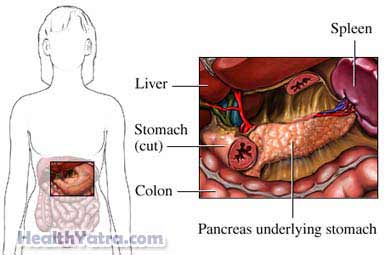Definition
Pancreatic cancer is the growth of cancer cells in the pancreas. The pancreas is a long, flattened pear-shaped organ in the abdomen. It makes digestive enzymes and hormones including insulin.

Cancer occurs when cells in the body divide without control or order. If cells keep dividing uncontrollably, a mass of tissue forms. This is called a growth or tumor. The term cancer refers to malignant tumors. They can invade nearby tissue and spread to other parts of the body.
Causes
The cause is unknown. Research shows that certain risk factors are associated with the disease.
Risk Factors
Factors that increase your risk of developing pancreatic cancer include:
- Age: 40 or older
- Sex: male
- Smoking and using smokeless tobacco (eg, chewing tobacco)
- Alcohol abuse
- Diabetes
- Chronic pancreatitis, hereditary pancreatitis, family nonpolyposis colon cancersyndrome
- Family or personal history of certain types of colon polyps or colon cancer
- Family history of pancreatic cancer (especially in Ashkenazi Jews with BRCA2 [breast cancer associated]) gene
- High-fat diet
- Overweight or obese, which may also reduce your chance of survival from pancreatic cancer.
Symptoms
Pancreatic cancer does not cause symptoms in its early stages. The cancer may grow for some time before it causes symptoms. When symptoms do appear, they may be very vague. In many cases, the cancer has spread outside the pancreas by the time it is discovered.
Symptoms will vary depending on the location and size of the tumor. Symptoms include:
- Nausea
- Loss of appetite
- Unexplained weight loss
- Pain—in the upper abdomen, sometimes spreading to the back (a result of the cancer growing and spreading)
- Jaundice—yellowness of skin and whites of the eyes; dark urine (if the tumor blocks the common bile duct); tan stool or stool that floats to the top of the bowl.
- Weakness, dizziness, chills, muscle spasms, diarrhea (especially if the cancer involves the islet cells that make insulin and other hormones)
These symptoms may also be caused by other, less serious health conditions. Anyone experiencing these symptoms should see a doctor.
Diagnosis
The doctor will ask about your symptoms and medical history. A physical exam may be done. The doctor may order blood and urine tests, as well as check for hidden blood in bowel movements.
Test may include:
- Upper gastrointestinal (GI) series—a series of x-rays of the upper digestive system taken after drinking a barium solution
- Computed tomography (CT) scan —a type of x-ray that uses a computer to make pictures of structures inside the abdomen
- Magnetic resonance imaging (MRI) scan —a test that uses magnetic waves to make pictures of structures inside the abdomen
- Ultrasonography—a test that uses sound waves to find tumors
- Endoscopic retrograde cholangiopancreatography (ERCP) —a type of x-ray that shows the pancreatic ductal system after dye has been sent through a tube down the throat and into the pancreas
- Percutaneous transhepatic cholangiography (PTC)—a type of x-ray test that shows blockages in the bile ducts of the liver
- Angiography—x-rays of blood vessels taken after an injection of dye that makes the blood vessels show up on the x-rays
- Biopsy—removal of a sample of pancreatic tissue to test for cancer cells
Treatment
Once cancer of the pancreas is found, staging tests are performed. These test help to find out if the cancer has spread and, if so, to what extent. Treatments for pancreatic cancer depend on the stage of the cancer.
Treatments include:
Surgery
Removal of the cancerous tumor and nearby tissue may be done. Nearby lymph nodes may also need to be removed. In pancreatic cancer, surgery may also be performed to relieve symptoms. Surgeries include:
- Whipple procedure—removal of the head of the pancreas, part of the small intestine, and some of the tissues around it
- Total pancreatectomy—removal of the whole pancreas, part of the small intestine, part of the stomach, the bile duct, the gallbladder, spleen, and most of the lymph nodes in the area
- Distal pancreatectomy—removal of the body and tail of the pancreas
Radiation Therapy (Radiotherapy)
This is the use of radiation to kill cancer cells and shrink tumors. Radiation may be:
- External radiation therapy—radiation directed at the tumor from a source outside the body
- Internal radiation therapy—radioactive materials placed into the body in or near the cancer cells
Chemotherapy
Chemotherapy is the use of drugs to kill cancer cells. It may be given in many forms including pill, injection, and via a catheter. The drugs enter the bloodstream. They travel through the body killing mostly cancer cells. Some healthy cells are killed as well.
Biological Therapy
The use of medications or substances made by the body. They can increase or restore the body’s natural defenses against cancer. It is also called biologic response modifier (BRM) therapy.
Combined Modality Therapy
Most times, pancreatic cancer is discovered at an advanced stage. Surgery may not be appropriate in this case. If surgery cannot be done, then chemotherapy and radiation are offered together to prolong survival.
Surgery would be appropriate in only 25% of patients with this disease in the early stage. In these cases, the patient would benefit from surgery. After surgery, follow-up chemotherapy and radiation therapy have been found to prolong survival in some cases.
Prevention
If you think you are at risk for pancreatic cancer, talk to your doctor about ways to reduce your risk, such as:
- Quitting smoking
- Reducing how much alcohol you drink or not drinking any alcohol
- Losing weight if you are overweight
- Eating a healthy diet
- Taking steps to prevent getting diabetes (eg, diet and exercise)
- Avoiding exposure to cancer-causing agents (eg, if you work in the petroleum or dry-cleaning industries)
